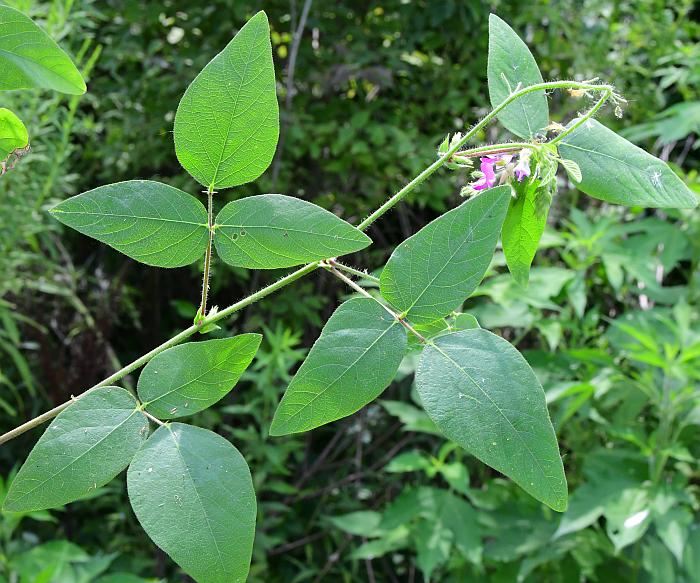Desmodium canescens (L.) Poir.
Hoary Tick Trefoil

Native
CC = 5
CW = 5
MOC = 57
© SRTurner
Desmodium canescens (L.) Poir.Hoary Tick Trefoil | |
 |
Native CC = 5 CW = 5 MOC = 57 |
© SRTurner |
|
Family - Fabaceae/Faboideae Habit - Perennial forb. Stem - Ascending to erect, to 2.0 m, typically branched above, the median portion with moderate to dense, straight spreading and shorter hooked hairs.
Leaves - Alternate, petiolate, trifoliate. Petioles of median leaves 3-10 cm long, often only slightly shorter toward the stem tip (but the bracteal leaves often much reduced). Stipules 7-15 mm long, 3.0-4.5 mm wide, broadly ovate with the base asymmetrically lobed and partially clasping the stem, angled or tapered to a sharply pointed tip, at maturity brown and reflexed, persistent. Leaflets flat or nearly so, the undersurface with numerous hooked and spreading hairs especially along the veins, the network of raised veins conspicuous. Central leaflet 4-12 cm long, 2.5-7.0 cm wide, ovate to ovate-lanceolate, the tip sharply or bluntly pointed. Lateral leaflets 3-9 cm long, 1-5 cm wide. Stipels 2-4 mm long, hairlike.
Inflorescences - Terminal and from the upper leaf axils, branched, the axis with hooked, spreading and multicellular glandular hairs. Primary bracts 4-8 mm long, narrowly ovate, tapered to a sharply pointed tip. Secondary bracts 1.5-2.5 mm long, linear. Flower stalks 7-14 mm long.
Flowers - Calyces green, moderately long-hairy and densely very short-hairy, the margins conspicuously hairy, the tube 1-2 mm long, the lobes 3-5 mm long. Corollas papilionaceous, 8-11 mm long, pink or rarely white, the nectar guides green and white outlined in purple.
Fruits - Loments, straight or slightly curved upward, the stalklike base 2-3 mm long, consisting of 3-6 segments, each 5-14 mm long and 4-7 mm wide, rhombic with deeper indentations below, the hooked hairs confined mostly to the segment margins, the faces nearly glabrous. Flowering - July - September. Habitat - Bottomland and mesic forests and forest margins, upland prairies, streambanks, ledges of bluffs, fencerows, fields, pastures, levees, railroads, and roadsides. Origin - Native to the U.S. Lookalikes - Other species of Desmodium, especially D. canadense. Other info. - This relatively showy species of tick trefoil is found in scattered locations throughout much of Missouri, most commonly in the southern half of the state. It also occurs in scattered locations throughout the southeastern continental U.S. Plants in this genus can be difficult to identify to species. This one is characterized by relatively large flowers, relatively large, broad stipules which clasp the stem, long leaf petioles, and leaf undersides which are uniformly pubescent with tiny hooked hairs. Photographs taken at Marais Temps Clair Conservation Area, St. Charles County, MO, 8-5-2021 (SRTurner). |